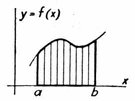
COURSE INFO
SCHEDULE
SYLLABUS
HOMEWORK
WRITING ASSIGNMENTS
OFFICE HOURS
|
Math 126, Spring 2006
Calculus 2
Writing Assignments
Give brief but clear answers to the questions below. Click on this link to send me an email with your answers. Make sure to type 'Calculus Assignment' and the date in the subject line.
For Thursday, March 2
Section 8.1 & 8.2: Arc Lengths and Surface Area
- How does the formula for Arc Length come about as a consequence of the Pythagorean Theorem?
- How does computing the surface area of an object fit in with our scheme of breaking up larger objects into smaller components?
- Read exercise 25 and explain the 'paradox' that arises if we think of Gabriel's Horn as a paint can.
For Friday, March 3
Section 8.4 Applications of Economics and Biology
- Explain the term 'consumer surplus'. What factors might lead the demand curve to be a 'curve' rather than a straight line?
- Why might the velocity of blood be greater near the center of a vein?
- Read exercise 15 and explain why the output concentration function makes sense.
For Tuesday, March 7
Section 6.5 and 8.5 Applications to Probability
- Look at the picture on the top of page 446. How does the average value of a function relate to the area under its curve?
- Explain the concept of a probability density function.
- Read the example on page 589. Why is the median wait time less than the average wait time?
You may download a copy of the practice exam here. We will go over this on Thursday. Come prepared with questions that will clear up your confusions about the material. Here is a copy of the solutions to that exam.
For Thursday or Friday, 9 or 10 March (or later)
Midterm assessment (may be completed any time before the end of Spring break). You may answer these questions through campus mail or borrow a friend's email account if you want to keep your answers anonymous)
- What is going well in class thus far? What could be going better?
- What am I doing well as a professor thus far? What could I be doing better?
- What are you doing well as a student thus far? What could you be doing better?
For Tuesday March 28
Section 11.1: Introduction to Sequences
- What does it mean for a sequence to approach a limit?
- Give an explanation of how a sequence can have an infinite limit.
- What nice properties do sequences have that limits have? That derivatives and integrals have?
- Comment: The test was easier/about as hard/harder than I expected it would be.
For Thursday, March 30
Section 11.2: Introduction to Series
Note: You'll need to review your notes (or someone else's notes) from Day 1, and refamiliarize yourself with sigma notation.
- How do we get a series from a sequence? How do we get a sequence from a series?
- Explain Theorem 6 (page 718) in words.
- Research Zeno's Paradox, and explain how it fits into a discussion of Geometric Series.
For Friday, March 31
Section 11.3: The Integral Test
- How can we tie the convergence or divergence of a series to the convergence or divergence of an integral?
- How does the harmonic series serve as a 'boundary' between convergent and divergent p-series?
- How can we use the integral test to tell how accurate an estimate we can get on a series sum?
Give brief but clear answers to the questions below. Click on this link to send me an email with your answers. Make sure to type 'Calculus Assignment' and the date in the subject line.
Barry Balof's Home Page
Whitman Math Home
Whitman College Home
|
